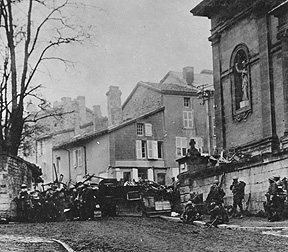Ménage
There are three meanings to this word and that only through the conversation will you know what someone is talking about:
-- housework
-- the household
-- marriage
If there's one thing I'm learning about the French language, it is that it is highly contextual!
Bisous -- bison
There is definitely a difference between kisses (pronounced BE-sue) and bison (pronounced BE-zone).
Ready to wear or ready to live?
habiller = to wear
habiter = to live
Dodo -- dos-d'âne
There's a big difference between getting an infant or small child to sleep (pronounced: dō DŌ) and getting over a speed bump (pronounced: dō DAHN). The second refers to the back of a donkey.
lever -- laver -- lever -- élever -- réveiller
Which way is up??? Again, it depends on how you say it.
lever (le-vay) = get up
laver (la-vay) = wash up
lever (leu-vay) = raise up
élever (A-leu-vay) = elevate up
réveiller (ray-vay-yay) = wake up
pluie -- il pleut -- il pleure
Keeping these words straight is the ultimate challenge (défi).
pluie (plu-ee) = rain
il pleut (eel ploo) = it's raining
il pleure (eel pler) he's crying

recto verso -- reversible
 There is a big difference between copying on both sides (recto verso) of a piece of paper and wearing a reversible (reversible) coat or jacket.
There is a big difference between copying on both sides (recto verso) of a piece of paper and wearing a reversible (reversible) coat or jacket.desert -- dessert
Just as in English, these two words mean different things through their pronunciation.

dE-zer is the place of sand and a lack of water
dess-ER is what you eat at the end of a meal
seulement -- saumon
It was at the end of my meal at a restaurant and I asked "only for tea." However, what came out was my asking for salmon because of my mispronunciation of the word for "only." After my hosts realized my mistake, they directed the confused waiter to give me the tea I wanted. I had left the le out of seulement.
Seulement is pronounced se-le-mont.
Saumon is pronounced sa-mon









































